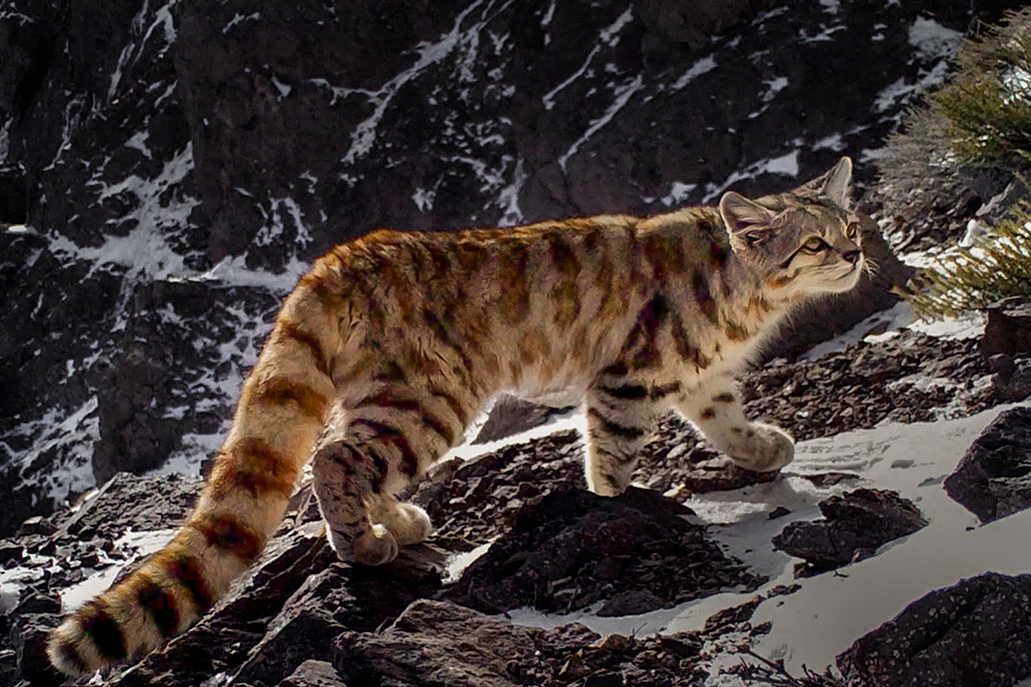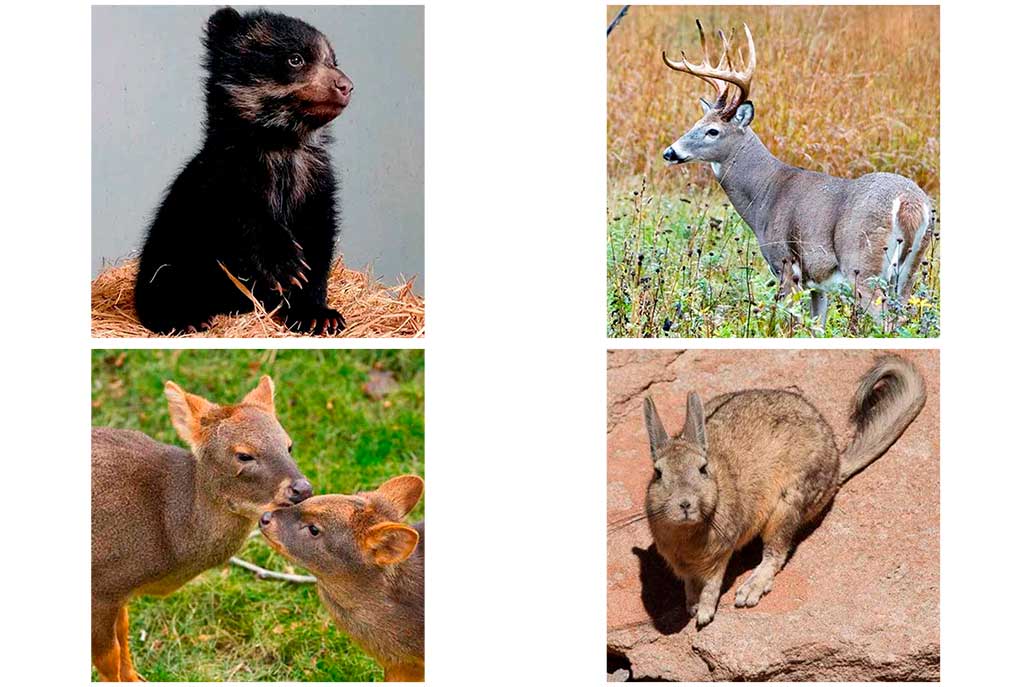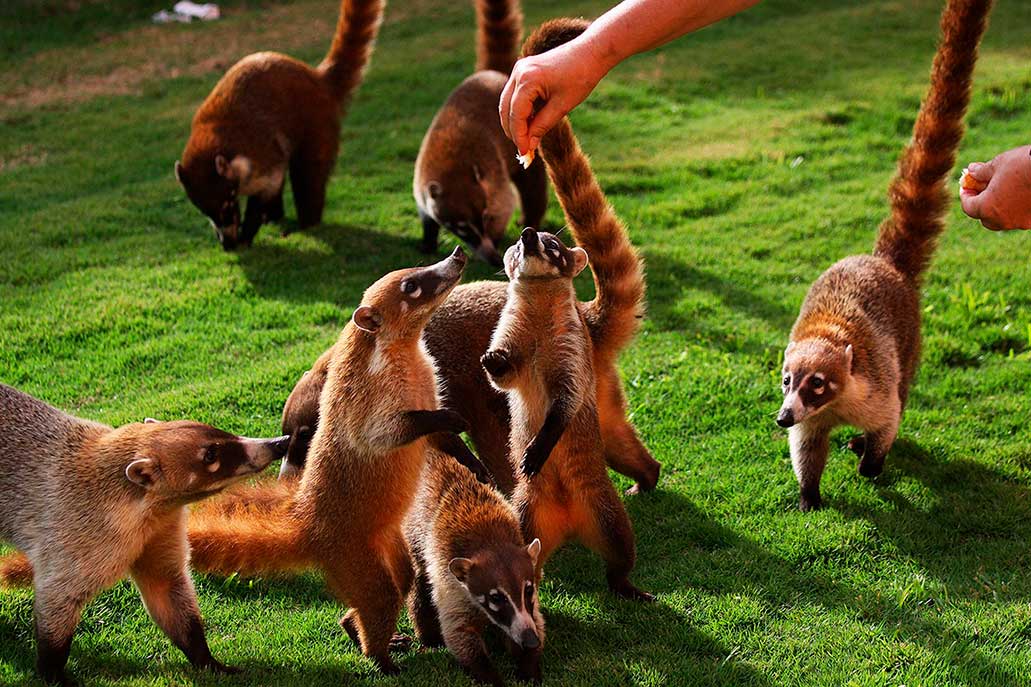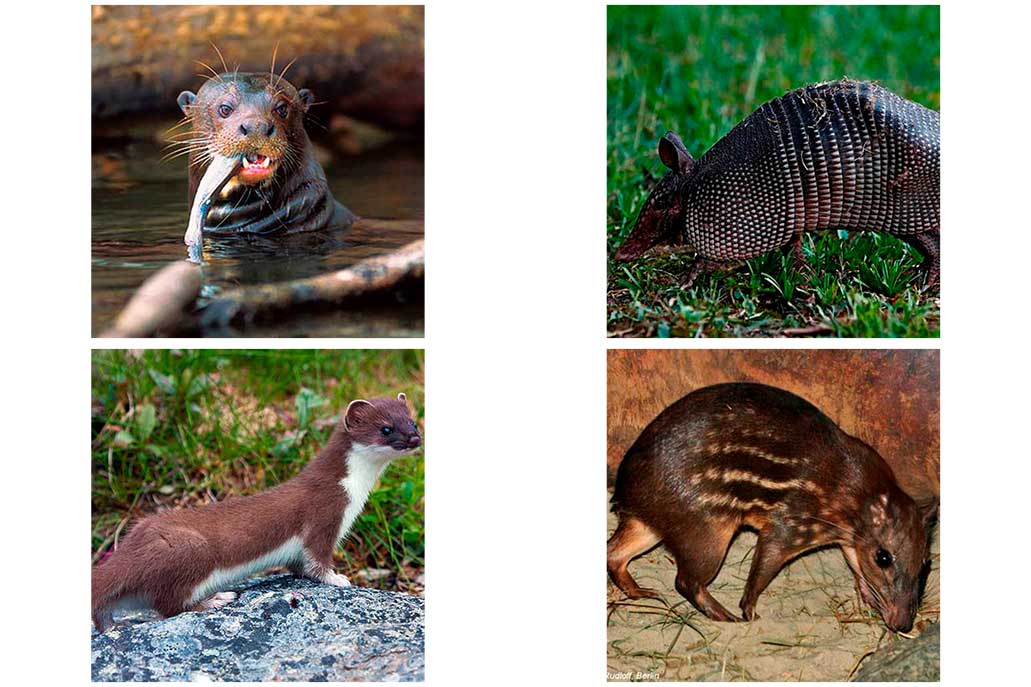The fauna of Machu Picchu: Mammals in the sanctuary of Machu Picchu
The archaeological site of Machu Picchu is located within the Machu Picchu Nature Reserve. Within this territory, you can find different species of animals and a variety of plants where orchids stand out. However, now we will focus on talking about and showing some of the mammals that can be found in their natural state. The high jungle where all these animals develop has unique characteristics that help different species to live. Unfortunately, we will know cases of some animals in danger of extinction that seem to be coming to this natural area protected by the Peruvian state.
Content
Andean or grass cat
Thanks to some investigations that were carried out near the archaeological sites that are connected through the Inca Trails. It was possible to find new species that seemed not to belong to the historical and ecological sanctuary of Machu Picchu. Among these new species, it was possible to verify the existence of important felines in which we can highlight the presence of the puma and the ocelot. However, one of the species that was the most pleasant to find was the pajonal cat, which should also be known as the “Andean cat”, but some prefer to call them differently. It is well known that little is known about this species, so it was a total joy to find it with the camera traps that were left in the area of Piscacucho and Wiñayhuayna.
The Andean cat is one of the most beautiful cats that can be found in South America. It has a brownish-yellowish coat with many spots along its back. One of the main characteristics is that on its front legs, it has 3 spots that look similar. In addition, it has a long tail with abundant hair, which gives it a robust appearance. This tail also has black spots, giving the impression of having a ringed tail. Counting its tail, it can measure up to 1 meter long, the tail being a third of its entire dimension. His chest color is a shade lighter than the rest of his fur. It is a robust cat.
Being a feline, the Andean cat is carnivorous, its main sources of food are obtained from rodents that it easily hunts. It can also feed on ducks and larger rodents such as guinea pigs wild hares and vizcachas. It is an excellent hunter, during the mating season, it is the only time when males and females can coexist. Later, only the female takes care of the young. The gestation time reaches 85 days and can give birth to up to 3 little kittens. It is estimated that grassland or Andean cats can live 16 years, reaching sexual maturity at two years of age. Numerous organizations are currently creating various campaigns to prevent hunting and preserve natural habitats to aid in the recovery of the feline population.
The spectacled bear
Many tourists and hikers say they have seen a spectacled bear on the tours of the Inca Trail. There have been similar instances where these magnificent creatures were spotted during the temporary shutdown of the Machu Picchu archaeological site. This was the product of the pandemic caused by the Covid-19 virus. For this reason and other sightings near Machu Picchu; The spectacled bear is one of the most representative animals of this entire region. Especially from the entire geographical sector known as cloud forests or high jungles. The spectacled bear is one of the largest predators in this entire ecosystem. Due to the presence of few animals and the very difficulty of finding protein sources, the spectacled bear feeds mostly on vegetables and fruits. These products are easier to find throughout the Machu Picchu nature reserve.
The spectacled bear receives this name because, among the fur on its face, it has a lighter color (white or yellowish) that resembles the presence of glasses. At the same time, the rest of his fur is entirely black. Although bears in the jungle of Puno and high Andean areas you can find copper or brown bears, but with the same detail on the face. As we mentioned, it has a diet more focused on fruits and vegetables. This is probably the main factor that prevents it from developing a gigantic body like its North American relatives that can reach up to 3 meters in height. While the spectacled bear is barely 2 meters, if he stands up. Being one of the smallest bears.
The great presence of food throughout the year does not allow it to hibernate. Unlike its relatives in other parts of the world, the spectacled bear can survive without hibernating. This allows you to cover large domain areas when marking your territory. During the mating season, there have been cases where bear couples live together for a week, after which both separate. In this sense, only the female is in charge of raising the cubs. Like all hunting animals, bear cubs learn to hunt and find food by playing with each other or by following their mother.
The spectacled bear represents an important reference for cultures and worldviews, linked to the Andean and Amazon. In these spaces, it is called “Ukuku” and “Ukumari”. According to both worldviews, it has a special connection with nature because it is the link between the living and the dead. In some cases, they relate it to the creator of life, according to the Matsiguengas. They probably attributed these characteristics to it because it is one of the most intelligent and skillful bears, especially when it comes to climbing and swimming. In some cases, it was even seen that he builds his places to nap or rest.
The vizcacha
It is one of the animals that can be seen without any problem during the tour of the same Inca citadel. Cases were reported in which some groups or colonies of vizcachas that inhabit the walls of Machu Picchu were found. These specimens are somewhat small compared to the vizcachas that can be found in the wild. Vizcachas in their natural state can measure up to 50 centimeters and weigh up to 8 kilos. Despite this weight, they are quite agile as they belong to the rodent family.
The Andean vizcachas usually colonize rocky spaces, so it was easier for them to adapt to the citadel of Machu Picchu. They usually feed on some seeds, fruits, and even some grasslands. They dig their caves in the form of tunnels that can even reach 3 meters deep. When living among several individuals, cases have been recorded in which they usually share spaces, huddling up when sunbathing, while some members are in charge of alerting the rest of the colony.
The vizcachas are wild rodents, that is, they live freely. These little rodents have lived like this forever. According to the chronicles of the Inca Garcilaso de la Vega, the Vizcachas were hunted by the Inca population to later use their fur. The leather or fur of the vizcacha was used to make suits for the elite since it served as decoration for said garments. On the other hand, vizcachas can also be found in higher altitude areas, where they already have a more yellowish or gray color.
By living among rocky sites and in a colony, the vizcachas help each other during the care of newborns. The gestation time in the vizcachas is between 120 to 135 days. The main characteristics of the vizcacha are that it has long ears and a médium-long black tail. All the fur that covers it is abundant and thick and covers part of its legs and its 4 fingers.
Ring-tailed Coati
The ring-tailed coati is a mammal that bears some similarity to raccoons. However, it is a bit smaller. It has a size between 40 to 140 cm in length including its long tail. The coati has a long pointed nose that allows it to detect passing insects or insert its snout into small openings. Precisely from these two characteristics comes its name, which refers to a “long nose and tail”. It also uses its sharp claws to dig wet ground in search of insects or larvae. They know where to dig or find the juiciest insects thanks to the effective sense of smell that their long nose gives them.
A few days ago, a small family of coatis was recorded having a short walk through the archaeological site of Machu Picchu. During the video you can see the coati parents, guiding their young when they climb the stone walls or jump over an obstacle. The short walk quickly went viral. That is why we were all able to see their characteristic ringed tails that contrast in dark tones, between brown and black that can cover part of their back. Although there are some coats, which have a black back or have a color variation that plays with both colors. It is also possible to appreciate its small legs, which give it a robust appearance but that does not take away from its agility at any time.
One of their main customs and ways of life is that they are quite social animals. For this reason, they usually form small colonies of more than 30 members. As for the measurement obtained with all four legs resting on the ground, it does not exceed 30 centimeters. Coatis can also feed on some fruits. They are good at climbing trees, so in addition to feeding on fruits, cases of feeding on eggs and chicks have been recorded. Some studies of the behavior of coatis suggest that the herds or bands they form are made up of two females and several young males. Since adult males tend to be solitary.
In their contact with human beings, they are not usually shy, on the contrary, cases have been registered; outside of Machu Picchu, where coatis approached humans in search of food. In this case, it is recommended to be prudent and avoid touching them. However, the coatis and Peruvians work side by side to produce one of the most expensive and most demanded coffees in the world. The coatis eat the coffee fruits and then, from their feces, they proceed with the elaboration of said coffee. This practice began in Chanchamayo, which belongs to the Peruvian Amazon. In this region, the coatis are known as “mishashos”.
The short or little pudú
The small pudú is considered the smallest deer in the world. It’s like appreciating a miniature deer. This small animal with nocturnal habits can only be found in South America, where it is known as rabbit deer or páramo deer. Its natural habitat has a great size and territorial expansion, since altitudinally, it can live and develop from 2,000 to 4,000 meters above sea level.
Within Machu Picchu, it can only be found within the ecological sanctuary or the natural reserve area. In addition, spotting it during the day is difficult because it has nocturnal habits to avoid predators. It is almost the size of a sheep, although it has a lighter body. It has a length of 70 centimeters, while on its legs it reaches a height that does not exceed 40 centimeters. The maximum weight of the small pudú is only 6 kilograms. As for its fur, it has a brownish-red mantle that covers the entire trunk. On the head and legs, it has blackish fur.
One of its main characteristics is the strong legs it has. The forces of these legs give them a particular speed that in some cases can represent a danger even for the hunter since the adult pudús have small antlers. The couples that are formed live together until the end of their days. Unfortunately, they can only have one pup per year, at best. Due to their behavior, it is very difficult for couples to meet and even more so on their nocturnal tours. In addition, they are very careful when raising the newborn. They usually spend the night inside the forests while looking for food. Finding a pudú in the wild is complicated.
Whitetail deer
The white-tailed deer is one of the most beautiful deer that can be found anywhere in the world. The presence of this mammal covers an extensive territory covering the entire mountainous fringe of the American continent. It is for this reason that it can be found from Canada to some sectors of Peru. This deer was seen in the higher altitude areas of the ecological sanctuary, but also within the forests of Machu Picchu. They can be found in the higher altitude areas, which would be linked to the Inca trails.
The white-tailed deer feeds mainly on the ferns and shrubs that usually grow without problems in the aforementioned areas. It is a ruminant animal, so it is usually in the woods resting peacefully, but always alert to any attack. Thanks to its great adaptability, it also feeds on leaves, small plants, and shoots. In some cases, it usually feeds on some fruits and seeds. The wide variety of foods that it tolerates allows it to live at different altitudes and types of climates.
Being able to live without problems in different climates, their fur changes color depending on the habitat. It presents a reddish mantle during the summer, especially in the north of the continent. As for lands of lower altitude and with a more tropical climate, the white deer presents a yellowish mantle almost of an ocher tone. However, something that does not usually change is the gray-brown color of the legs and the white-tipped tail. They usually beat their tails as a signal of alarm or to show some concern.
Like most deer, it presents the famous sexual dimorphism. The individuals from the north of the continent are larger and more robust. These deer arrive between 60 to 160 kilograms, in the case of males. While females have an average weight of between 40 to 105 kilograms. The species that can be found in the ecological sanctuary of Machu Picchu reach barely 60 kilograms. The males, in any of the geographical spaces, have an ornamentation that grows continuously and that most confuse with horns.
The giant otter
It is one of the largest otters in the world. Although it has a certain resemblance to sea otters, it has more differences than them. The giant otter is carnivorous and normally feeds on fish. This species reaches 150 to 180 centimeters in length, having a weight that averages between 35 and 45 kilograms. This animal is found within the Machu Picchu sanctuary that converges with the cloud forests that are connected through the rivers. They live in small herds of more than 8 members between adults and young.
The herd that forms is led by a dominant pair. The members of these packs are usually very close, just as are the pairs of sea otters. Likewise, giant otters show a great ability to adapt to aquatic or terrestrial lifestyles. His entire body is enabled to give him great capacity and agility to carry out a normal life in both places.
The body of the giant otter is robust and elongated. It has a long tail that allows better maneuvering when swimming and balance when running. As for its fur, it has a short coat that varies between dark brown tones. Like all mammalian animals that have amphibious activities, it has two layers of fur. The first of them, which is the outer layer, is extremely dense since it is responsible for trapping water and functioning as a waterproof layer. While the inner layer is less dense and fulfills a temperature-regulating role. Unfortunately, this dense fur was so coveted between the 1950s and 1960s that the hunting of giant otters increased, just to obtain their velvety fur.
Although no pertinent studies on the reproduction of giant otters have been carried out. It is believed that they wait for the dry season when the rains subside. In this way, they ensure a better space for the young to grow. In this sense, they could start the mating season 6 or 7 months before the rainy season. The young go through a short development process. The body of the pups is suitable for swimming from 14 weeks old. Finally, we only have to mention that we look forward to seeing the otter population grow again since it is currently an endangered species.
Quirquincho or armadillo
They are small animals compared to the animals we already touched. This small mammal is found in different geographical spaces throughout South America. For this reason, it is possible to find this small space among the highest altitude forests of Machu Picchu and also in the high Andean areas that adjoin the high jungle. If you have already done the Inca Trail or a tour of hiking trails, you will surely find how these two very different geographies contrast. The yellow of the high Andean areas covered with ichu contrasts with the green and abundant vegetation of the high jungle. It is precisely there, where you can find the quirquincho.
The quirquincho or armadillo has nocturnal behavior. That is why, during the day, it can be found in the tunnels it digs thanks to its sharp claws and strong legs. These excavations serve as burrows or small homes to outwit predators. During its nocturnal outings, it feeds on minor insects and also on some fruits that fall to the ground or are wasted by birds or other animals. Likewise, cases were recorded in which the armadillo fed on some corpses and small animals. So it is known as an omnivore.
One of its main characteristics is that it has a frame that covers its entire back, tail, and part of its head. This gives it the appearance of being quite resistant. These plates are the alignment of bone cells, hence the solid appearance they present. Likewise, thanks to this frame, it can roll itself up like the pangolins of Africa. The armadillos or the quirquinchos, receive the scientific name of Cabasoous Centralis. This, unlike other species of the same family, has a more yellowish color. Only this species can be found in Cusco and throughout South America, several similar species are already extinct.
The weasel
The weasel belongs to a select group of innate hunters and is one of the most voracious. This small animal can be seen in different territories that can range from 1,100 to 4,000 meters above sea level. For this reason, it is possible to find it among the Andes of Cusco that connect with the high jungles until reaching the most tropical areas. The ecological sanctuary of Machu Picchu is made up of all these ecosystems and surely, in this territory, it is on the lookout for some prey.
Despite being even smaller than domestic cats, this animal has a more agile and slippery body. The body is elongated and the legs are short but powerful and have sharp claws, which allow it to hold its prey until it drowns it, inflicting strong damage on the spinal cord with its strong bites. The average size of the weasel that can be found in the Machu Picchu Natural Reserve area is 30 to 35 centimeters including the tail. Its main victims are usually birds, reptiles, small rodents, and in some cases animals larger than themselves.
Thanks to its small and even tender body, it earned the nickname of being the smallest hunter or predator in the animal kingdom. Of course, if we talk about mammals. Colors may vary depending on the geographical area in which it is located. The weasel’s fur ranges from brown or dark brown to dun, but maintains the brown hue, turning into a cinnamon mantle. Females usually give birth between 4 to 8 pups, after more than 34 days of gestation. During the gestation period, the couple stays together, once the pups reach the world the male leaves the burrow.
Due to its small size, it also makes it a victim of predators larger than itself. One of its main rivals and hunters is the suckling lambs. For this reason, weasels live in areas of abundant vegetation or steep areas and usually move around during the day. It uses its nose to chase its prey. During its hunts it jumps and confuses its prey since it usually stops in the middle of the hunt, to attack it stealthily or start a new chase.
The Montain Majaz
One of the largest rodents that can exist in South America is the mountain majaz. Also known as mountain “paca”. Its main habitat is within the cloud forests, typical of the high jungle of the historic sanctuary of Machu Picchu. It is an animal very similar to rats, only they do not have a tail. The size they reach is between 30 to 60 centimeters long. Although it looks like a small animal, it can weigh up to 10 kilograms. So it makes it an incredible source of protein for hunters.
It has a coat that can vary according to the season and where it has grown. The most characteristic tones are brown with light spots on the sides. It practically has the face of a giant rat, it has an elongated snout, bulging black or bluish eyes, and also medium-sized ears. On its legs, it has small claws ideal for holding food when eating. An important fact is that, like rats, the female usually has a greater volume and dimension.
The mountain majaz is herbivorous and usually feeds on fruits that usually fall from trees or other easily accessible fruits. To feed itself, it adopted a nocturnal life to avoid the presence of predators. In some cases, they feed on grass, shrubs, and tree leaves. They usually mate at any time, at the time of delivery, 1 or 2 mountain majaz arrive in the world. Once the mating is over, the male will continue with his life and it is the female who will take care of the upbringing. Within all this territory there are different rodents, in which an attempt is made to highlight the presence of the chinchilla. We hope the studies on wildlife in this region will soon be expanded and we can better expand this list of mammals in Machu Picchu.
By Imachupicchu – Last updated, August 22, 2024



